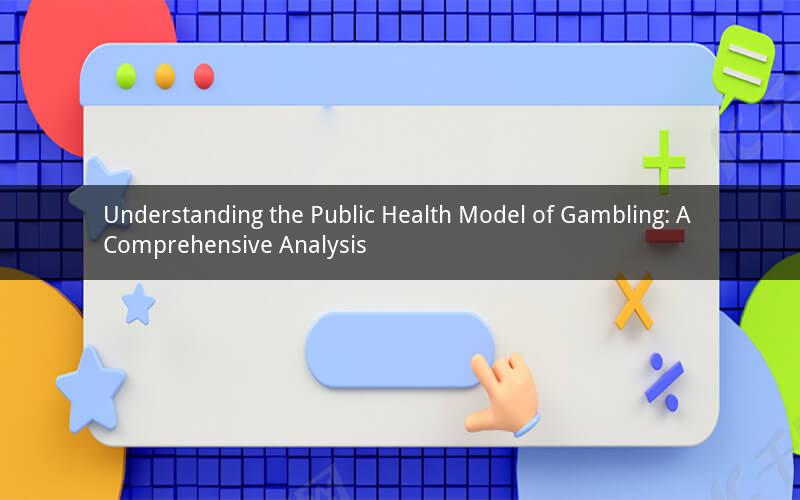
The public health model of gambling has gained significant attention in recent years as the gambling industry continues to expand globally. This model views gambling as a public health issue rather than a mere form of entertainment, emphasizing the importance of prevention, intervention, and treatment strategies. In this article, we will delve into the key aspects of the public health model of gambling, its underlying principles, and its implications for policymakers, healthcare professionals, and individuals alike.
I. Definition and Scope
The public health model of gambling posits that gambling can lead to a range of negative consequences, including addiction, financial distress, mental health issues, and social problems. This perspective is based on evidence indicating that gambling can cause significant harm to individuals and communities, warranting a public health approach to address the issue.
II. Underlying Principles
The public health model of gambling is grounded in several key principles:
1. Public Health Approach: This model focuses on the prevention, identification, and treatment of gambling-related harm, aiming to protect the public's health and well-being.
2. Multidisciplinary Approach: Combining insights from various fields, such as psychology, sociology, and public health, the model aims to address gambling-related issues comprehensively.
3. Stages of Problem Gambling: The model recognizes that problem gambling can evolve through various stages, from risk behavior to addiction, and tailors interventions accordingly.
4. Evidence-Based Practices: The model emphasizes the use of evidence-based approaches to prevent and treat gambling-related harm, ensuring that interventions are effective and efficient.
III. Key Aspects of the Public Health Model of Gambling
1. Prevention: Prevention efforts are designed to reduce the likelihood of individuals developing gambling-related problems. This includes raising awareness about the risks associated with gambling, implementing responsible gambling policies, and promoting healthier alternatives to gambling.
2. Early Identification: Early identification involves recognizing signs of potential gambling-related harm, such as changes in behavior, financial difficulties, or mental health issues. This enables early intervention and reduces the severity of problems.
3. Intervention: Interventions are tailored to address the specific needs of individuals with gambling-related problems. These may include counseling, therapy, support groups, and treatment programs.
4. Treatment: Treatment focuses on helping individuals overcome their gambling addiction and related problems. This can involve cognitive-behavioral therapy, motivational interviewing, and other evidence-based practices.
5. Policy and Regulation: Policy and regulation play a crucial role in shaping the gambling landscape and addressing gambling-related harm. This includes setting limits on gambling advertising, ensuring transparency in gambling operations, and providing resources for individuals struggling with gambling-related problems.
IV. Implications for Stakeholders
1. Policymakers: Policymakers should consider the public health model of gambling when developing gambling-related policies and regulations. This involves prioritizing public health outcomes and implementing measures to prevent and address gambling-related harm.
2. Healthcare Professionals: Healthcare professionals can play a crucial role in identifying and treating gambling-related problems. By incorporating gambling screening and intervention into their practice, they can help reduce the impact of gambling-related harm on individuals and communities.
3. Individuals: Individuals who engage in gambling can benefit from adopting a healthier approach to gambling and seeking help when needed. By understanding the risks associated with gambling and taking steps to protect their well-being, individuals can enjoy gambling responsibly.
V. Conclusion
The public health model of gambling offers a comprehensive framework for addressing the complex issues surrounding gambling-related harm. By focusing on prevention, early identification, intervention, treatment, and policy and regulation, this model aims to protect the public's health and well-being. As the gambling industry continues to evolve, it is crucial for stakeholders to adopt a public health perspective and work together to minimize the negative consequences of gambling.
Questions and Answers:
1. What is the primary objective of the public health model of gambling?
Answer: The primary objective of the public health model of gambling is to protect the public's health and well-being by addressing gambling-related harm through prevention, identification, intervention, treatment, and policy and regulation.
2. How does the public health model of gambling differ from a traditional gambling perspective?
Answer: The public health model of gambling differs from a traditional gambling perspective by emphasizing the potential harm associated with gambling and prioritizing public health outcomes, rather than focusing solely on the economic benefits of the industry.
3. What are some of the key principles of the public health model of gambling?
Answer: The key principles of the public health model of gambling include a public health approach, a multidisciplinary approach, recognition of the stages of problem gambling, and the use of evidence-based practices.
4. How can policymakers implement the public health model of gambling?
Answer: Policymakers can implement the public health model of gambling by prioritizing public health outcomes in gambling-related policies, setting limits on gambling advertising, ensuring transparency in gambling operations, and providing resources for individuals struggling with gambling-related problems.
5. How can individuals adopt a healthier approach to gambling?
Answer: Individuals can adopt a healthier approach to gambling by understanding the risks associated with gambling, setting limits on their gambling activities, seeking help when needed, and engaging in healthier alternatives to gambling.